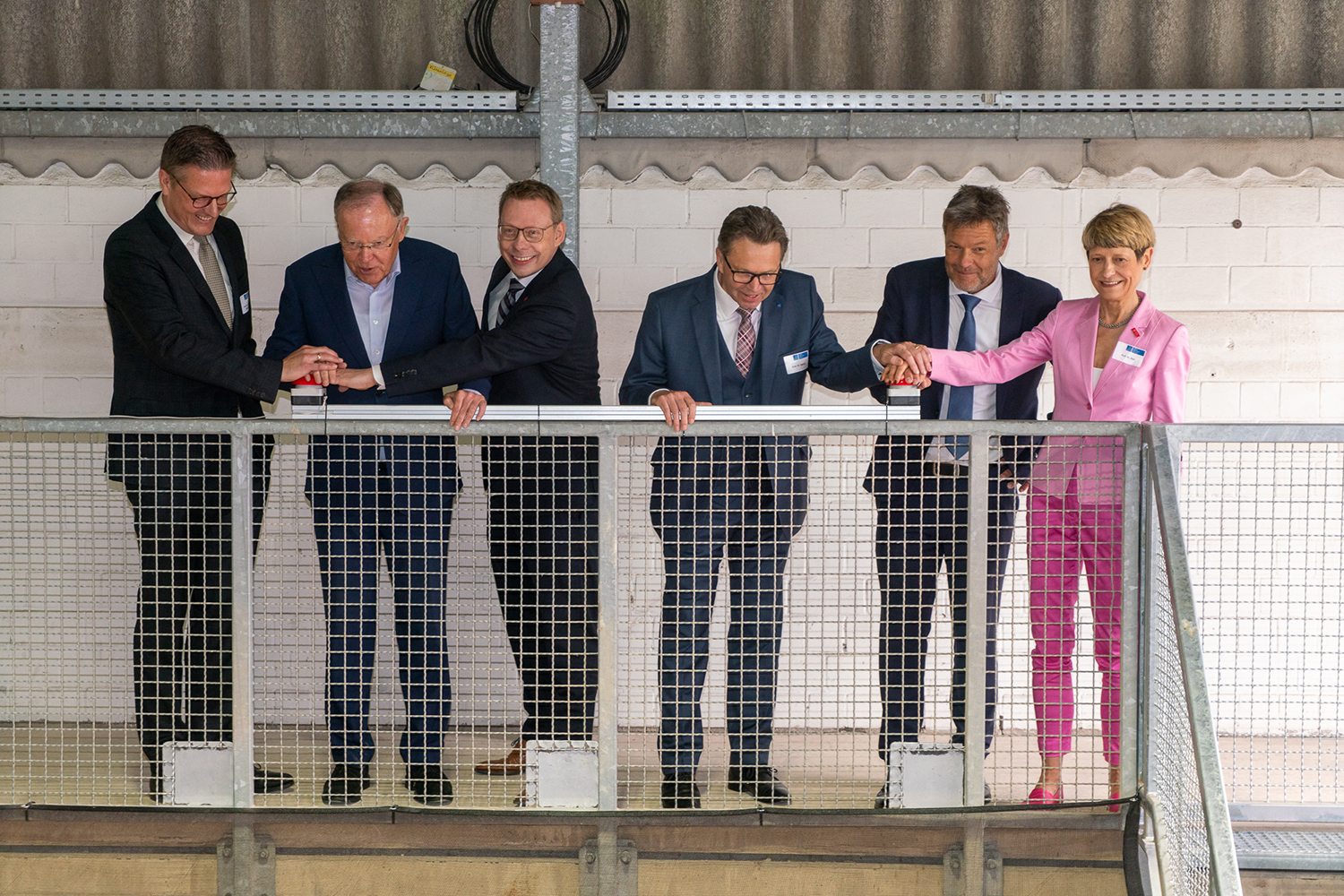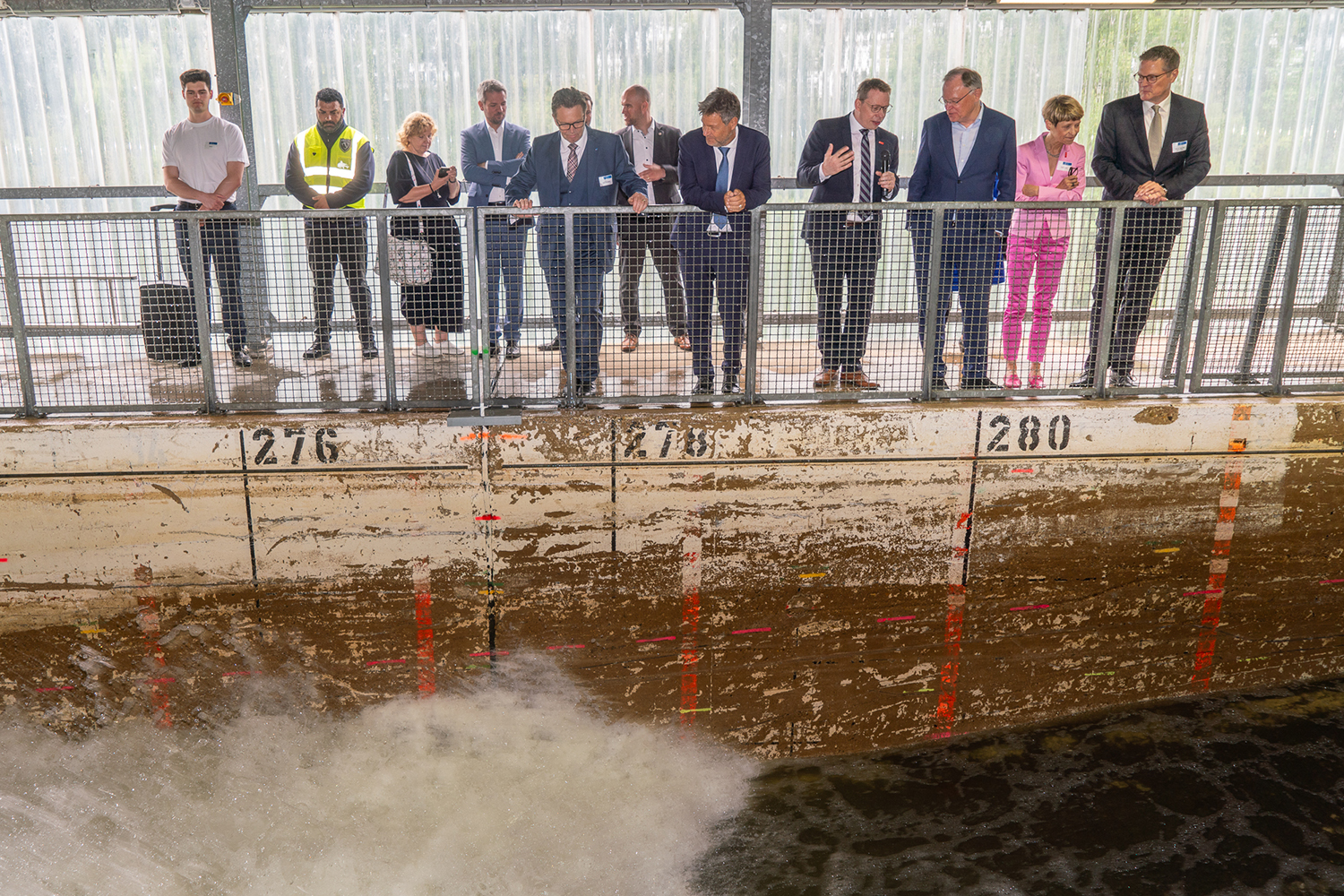Extended Large Wave Current Flume with the World’s Largest Wave Machine Opened Minister for Economic Affairs and Climate Protection Robert Habeck and Minister President Stephan Weil put the research facility into operation together with participants from the universities
Press release Leibniz University Hannover and Technische Universität Braunschweig
In recent years, Leibniz University Hannover and Technische Universität Braunschweig have designed and extensively expanded the new Large Wave Current Flume (GWK+) in Hannover-Marienwerder. More than 35 million euros have been invested to massively advance research on the energy transition in the GWK+. Among other things, fixed and floating foundation structures of offshore wind turbines are investigated here. Today, the globally unique large-scale research infrastructure was commissioned in the presence of Robert Habeck, Federal Minister for Economic Affairs and Climate Protection, and Stephan Weil, Minister President of Lower Saxony, together with the university presidents and the lead researchers.

They launched the first wave in the new Large Wave Current Flume: Federal Environment Minister Robert Habeck (2nd from right) together with TU President Prof. Dr. Angela Ittel and LUH President Prof. Dr. Volker Epping, as well as Lower Saxony’s Minister President Stephan Weil (2nd from left) with the two lead researchers Prof. Dr.-Ing. Torsten Schlurmann (l.) and Prof. Dr.-Ing. Nils Goseberg. Photo credit: LUH/Thomas Damm
After a ceremonial push of the button to start the plant, the first impressive three-metre-high wave built up in the 300-metre-long wave flow channel. Thanks to the expansion, the large-scale research infrastructure now has a powerful flow facility, a deep section for investigating foundation structures of offshore wind turbines and a high-performance wave machine for generating ocean waves up to three metres high. The conversion now makes it possible to generate waves and currents simultaneously – a new superlative for Hannover: no other facility in the world offers this possibility.
“Wind energy plays the central role in Germany’s electricity supply today and will continue to do so in the future. Conditioned by the increasing demand for electricity due to the electrification of other sectors, such as building heating with heat pumps or electromobility, the use of wind energy must be expanded quickly and efficiently. The wave flow channel in Hannover will make an important contribution to this by enabling investigations into the optimisation of offshore foundations. In this way, wind energy expansion at sea can become even more cost-effective and reliable. For this reason and because of the many other research aspects that can be investigated with the wave flow channel, the research funding of around 35 million euros made available by the BMWK is sensible and money well spent for the future,” emphasised Economics and Climate Protection Minister Robert Habeck in his welcoming address.
Lower Saxony’s Minister President Stephan Weil emphasised: “I am very pleased that we now have this wave flow flume in Lower Saxony, which is unique worldwide. This will provide research and industry with far-reaching new opportunities for the development of offshore wind turbines. And coastal protection, which is particularly important for Lower Saxony, can also be further researched and improved through the simultaneous generation of swell and current. All in all, a really impressive facility for which I can only warmly congratulate all those involved.”

The wave in the 300-metre-long wave flow channel reaches a height of three metres. Photo credit: LUH/Thomas Damm
Since the GWK was commissioned in 1983, numerous pioneering research projects have been carried out at the facility. However, the research approaches and requirements have changed considerably in recent times. Until now, only waves could be generated. With the aim of expanding marine renewable energies (offshore wind energy, tidal/wave energy and others), installation and operation concepts over the life cycle of these structures as well as the influence of tidal currents are coming more into focus. In 2017, the Federal Ministry of Economics and Climate Protection (BMWK, formerly BMWi) had therefore approved the research project “marTech – Development of Renewable Maritime Technologies for Reliable and Sustainable Energy Supply” at the request of the participating universities LUH and TU BS, in order to meet the requirements of research and industry in the expansion and operation of renewable energies. Since then, more than 35 million euros have been invested in the expansion of the Large Wave Current Flume (GWK+) Hannover. The Lower Saxony Ministry of Science and Culture (MWK) has supported the planning and land acquisition with around 1.4 million euros. The GWK+ is operated under the aegis of the joint Coastal Research Centre (FZK) of LUH and TU BS.
Prof. Dr. Angela Ittel, President of Technische Universität Braunschweig, and Prof. Dr. Volker Epping, President of Leibniz University Hannover, are very pleased that the GWK+ is now ready for research operations. “This research infrastructure will be able to make a significant contribution to the testing and development of renewable energy technologies on and from the sea. This also directly supports the research focus on energy, which Leibniz University has anchored in many areas in an interdisciplinary manner. In science, we will use our opportunities at Leibniz University to help further accelerate the transformation process of our energy systems at federal and state level,” emphasised Prof. Dr. Volker Epping.
“With our outstanding research at the Large Wave Current Flume, we are contributing to Europe’s energy transition and energy security. This unique research infrastructure gives us the opportunity to study offshore wind turbines as well as tidal energy plants under controlled conditions. We are thus strengthening Lower Saxony and Germany as a location for science and industry. Together with our industrial partners, we develop solutions that are technically mature and internationally competitive at the highest level,” said President Prof. Dr. Angela Ittel.
The leading researchers Prof. Dr.-Ing. Torsten Schlurmann, Leibniz University Hannover, and Prof. Dr.-Ing. Nils Goseberg, Technische Universität Braunschweig, both on the board of directors of the Coastal Research Centre, explained the scientific and technical background of the extended wave flow channel to the guests. “Here we can investigate the simultaneous loading from swell and current on a large scale and thus realistically on a large scale,” said Prof. Schlurmann. Steeper and higher waves, as predicted by climate change, can also be recreated in experiments in the future and loads on buildings simulated. With the likewise new, circulating current facility, tidal currents can be studied for the first time as in the sea. “The new deep section also makes it possible to simulate the part of offshore wind turbines located in the ground and to investigate movements of the ground and turbine that take place there,” explained Prof. Goseberg.
